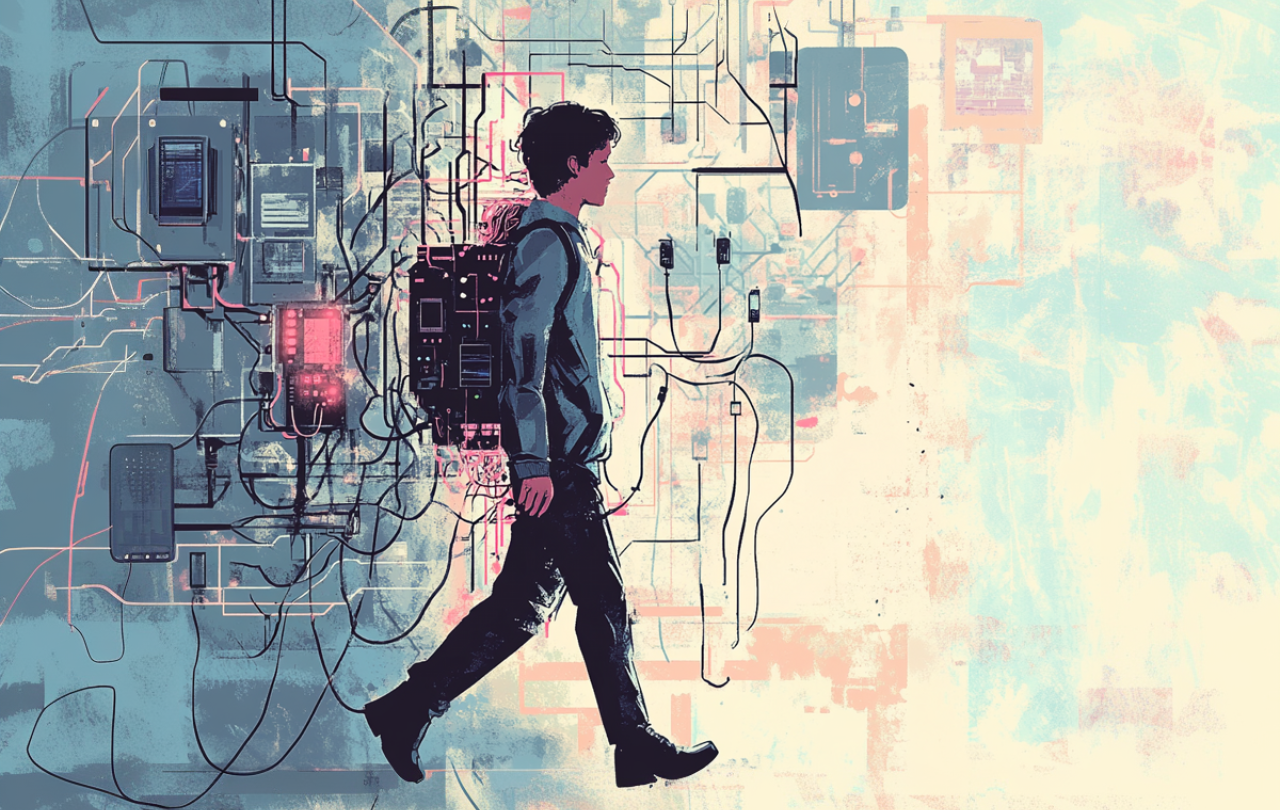
In my previous article, I outlined Heidegger’s suspicions about the technological age in which we live. We noticed that Heidegger saw a ‘way of being’ which lay underneath all the tech that fills our lives and that as members of a technological society, we have been shaped, or you could say ‘discipled’, to live in a certain way. This ‘way of being’, the essence of technology, is to see everything in the world primarily as a collection of tools and resources to be extracted as and when they are needed.
In contrast with the technology optimists that we looked at in the first article, Heidegger wants us to see that modern technology is not made up of neutral tools to be used for good or bad, nor is it simply a natural extension of human activity that we have been doing since the stone age. Modern technology has shaped a technological society and the members of that society, so that we position everything in the natural world (including ourselves and our neighbours) into resources to be mined.
So, if that is Heidegger’s diagnosis of modern technology – which he dubbed Gestell, what can we do about it? What is Heidegger’s solution to the problem that he identified? Is there a way to live free of the Gestell of modern technology? However, before we get to that question we first have to ask if it’s actually possible to do anything. Because, if Heidegger’s view of modern technology is correct and our thinking and being in the world have been so shaped by the essence of technology, we might be stuck within a way of thinking that has shaped us with no way to change.
A method or technique is simply a technology of self-transformation and therefore keeps us entrapped within the technological essence.
There are two reasons why we might not be able to fix the problem of technology that Heidegger has revealed to us.
Firstly, the problem of being trapped within a system that has formed our thinking: How could we think our way out of this technological age if we have already been shaped by that age’s way of being in the world? If the technological system is as totalising and has so powerfully shaped the minds of people within the society in the way that Heidegger suggests it would seem almost impossible to think beyond or around the system and therefore break out of it.
Secondly, there is the problem of using technological thinking to solve the problem of technological thinking. This second point is a natural extension of the first: within a technological society it will feel most natural to devise a series of techniques or methods that could be used to set people free from the technological age but, because they are techniques, they would do nothing more than reinforce the problems of technological thinking. Or to put it another way, we need a new way of thinking and being in the world that does not lead to just another method. A method or technique is simply a technology of self-transformation and therefore keeps us entrapped within the technological essence. Self-help books are the most obvious example of this. As Brian Brock says, “What must at all costs be avoided is trying to meet the problems raised by technological thinking using yet another technological or formalist decision-making method. The problem of technology lies in its addiction to methods of thinking and perceiving.”
Heidegger’s solution to the problem of Gestell is to invite members of a technological society to live open-handedly rather than grasping at the natural world.
Heidegger’s proposed solution to Gestell lies in another German word: Gelassenheit. If Gestell was about ‘positionality’, or ‘enframing’ then Gelassenheit refers to ‘releasement’, ‘tranquility’ or ‘letting things be for themselves’.
Heidegger develops the term Gelassenheit by inviting his readers to reject the desire that they find within themselves to force the natural world to conform to their needs. Secondly, and similarly, to invite the world around to present itself to the person rather than for the person. Heidegger’s solution to the problem of Gestell is to invite members of a technological society to live open-handedly rather than grasping at the natural world. The solution he offers is at the level of desire rather than activity. This is Heidegger’s only option given the diagnosis, if he were to offer a step-by-step solution to the problem of Gestell or a set of activities he would only be enframing the problem of enframing: one cannot use techniques to solve the problems of a technological age.
As Christopher Merwin says, “Heidegger’s account of releasement is neither a wholly active not, a wholly passive disposition… Heidegger is not a Neo-Luddite, and he does not think we can or should entirely abandon technology. Gelassenheit is not meant to overcome technology, but to place in check the tendency of technology to render everything into an object for use and production… Gelassenheit releases us from the danger of technology and opens us to alternative ways of relating to reality.”
Social media turns the human beings who use it into the content that it sells, we have become the resource that the machine is mining.
As a Christian and a priest in the Church of England, there is a lot about Heidegger’s analysis of our technological age that I find very compelling. I instinctively resonate with his existential description of the essence of modern technology as Gestell. When I observe my own habits, and when I listen to the stories of my parishioners, I see example after example of the technology in our lives training our sensibilities to treat the natural world as nothing more than a resource to be plundered for our needs and pleasures.
I think Heidegger’s concept of Gestell gives a real insight into why we are so far failing to curb our use of fossil fuels despite the near universal consensus that it would be a good and right thing to do. As a society, we have become conditioned to see nature as nothing more than a source of fuel to be harnessed. Our societal addiction to hydrocarbons begins with the assumption that oil is there for our use. It is only the Gestell mindset of a technological age which would make that assumption: oil isn’t there to be for itself but is instead positioned within the inventory as a useful and therefore valuable commodity to be harvested and deployed.
Beyond the natural resources of the creation within which we live, I see Heidegger’s analysis of Gestell at work in the attitudes of people to one another. It is becoming increasingly hard not to treat other human beings as nothing more than resources to be used or discarded depending on whether they fulfil their purpose or not. The ‘intention’ of the social media algorithm (obviously, this is an anthropomorphism: algorithms don’t have intentions) is to turn each of its users into content creators. We are encouraged to post, like, and share and we often fail to notice that the content we are ‘creating’ is ourselves. Social media turns the human beings who use it into the content that it sells, we have become the resource that the machine is mining. And while social media provides a stark example of human beings becoming little more than resources to be harvested, the effects of this technological mindset are not restricted to the virtual environment. When I fail to notice to person across the counter from me in the coffee shop, or the Uber driver, or the sales assistant, I am slipping into the Gestell mindset which characterises the problem of technology.
While I think Heidegger articulates the problem of technology more clearly and insightfully than almost anyone else in the modern era, I think his solution would benefit from deeper reflection on the Christian tradition.
Here we find a person through whom our minds can be transformed, who can set us free from the patterns of thinking of this world, who can reshape our desires.
Firstly, within the Christian tradition, there has long been the recognition of competing forces of discipleship. In the Christian worldview there is no neutral space of existence, our attitudes and desires are always being trained by one thing or another. In his letter to the church in Rome, Paul puts it like this: “Do not be conformed to this world, but be transformed by the renewing of your minds, so that you may discern what is the good and acceptable and perfect will of God.” Paul tells us that ‘the world’, or in our case ‘the essence of modern technology’, is constantly pulling our thinking into conformity with it. But Paul goes on to point us to something that Heidegger cannot, the voice from outside the system. In the face of a totalising and all-compassing technological society which en-fames everything as a resource waiting to be used, Heidegger’s encouragement is Gelassenheit, to, by force of will, release yourself and the world from the drive to Gestell. Heidegger has no other hope than the willpower of the individual to liberate themselves from the system because he has no other site of hope, nothing outside the system. Paul on the other hand points us to God. A source of transformation and life that is not conformed to the world and is not dependent on the world for existence but nevertheless, by an act of grace, has chosen to reveal himself within the world for the sake of the world. Here we find a person through whom our minds can be transformed, who can set us free from the patterns of thinking of this world, who can reshape our desires. This is the gift of prayer, a space to be and to allow God and the world to be. For many Christians, the experience of prayer is that through sheer inactivity and silence, they are (slowly, sometimes imperceptibly) transformed.
However, Heidegger alerted us to a significant difficulty in finding our way out of the technological mindset. Am I suggesting that we turn God into a method for transforming our minds so that we might escape the pitfalls of modern technological thinking? I hope not. While it is certainly possible to attempt to turn prayer into a technique for getting God to give you what you want, that is not what I’m suggesting here. I’m aiming instead of the sort of prayer that Mother Teresa famously described when she was once asked in an interview, "What do you say when you pray?" She replied, "Nothing, I just listen." The reporter then asked, "Well then, what does God say to you?" To which she answered: "Nothing much, He listens too."





